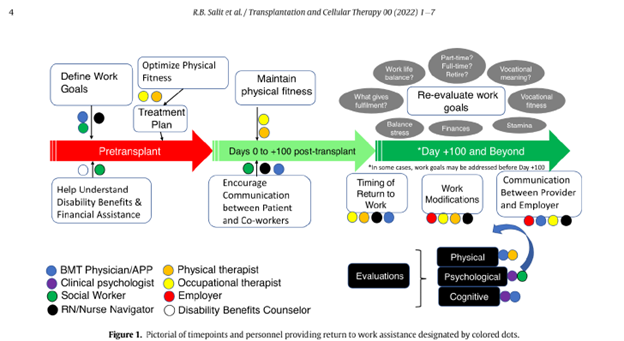The American Society of Transplantation and Cellular Therapy (ASTCT) assembled a committee of experts to review research on the barriers for patients with hematologic cancers returning to work after hematopoietic cell transplantation (HCT). The extensive literature review showed only about 50-60% of patients return to work after transplantation at a median 3-year follow-up post-transplant. Physical, psychological, and logistical barriers can prevent patients from returning to work and achieving this important post-transplant quality-of-life milestone. The ASTCT Return to Work Guidance Committee developed this evidence-based guidance to assist healthcare providers in addressing barriers and optimizing communication for the return-to-work journey.
Download a PDF of the full study summary with journal citation here: Research Brief
Background
Patients with hematologic cancers are at high risk for delayed return to work, unemployment, and reduced work capacity. Studies show that cancer survivorship services don’t routinely address return-to-work-related goals, and patients often must navigate barriers independently. Minimal data is available to guide return-to-work recommendations for post-HCT patients, warranting a review of the current state to provide better support for healthcare teams and their patients.
Study Details
The ASTCT assembled nine experts in HCT and return-to-work guidance for the Return to Work Guidance Committee, including two physical therapists, an occupational therapist, three oncologists with a specialty in HCT survivorship, a transplant infectious disease expert, a clinical psychologist with expertise in HCT survivorship, and a social worker with extensive experience managing HCT patients. The Committee performed a literature review which identified 30 publications for inclusion that focused on risk factors of failure to return to work and potential return to work facilitators, specifically regarding HCT and cancer survivorship.
Results
Most of the literature was not from randomized controlled trials, so the panel used a 3-tier, evidence-based grading system based on an approach to prior ASTCT guideline documents. Recommendations are sectioned according to the patient’s transplant journey timeline, from pre-transplantation through day 100+ post-transplant and beyond. Recommendations throughout the guidance suggest providers collaborate with patients about work-related goals, optimize physical fitness, and facilitate communication with the patient at each transplantation phase, as shown in the figure below. Post-transplant recommendations also focus on communication between the patient’s employer and the healthcare provider.
Key Takeaways
Patients receiving HCT need assistance from their healthcare providers in defining work goals, determining return-to-work readiness, and addressing barriers to promote optimal quality of life and survivorship. All healthcare team members can play a crucial role in navigating different obstacles and helping patients set return-to-work goals. Starting the conversation early pre-transplant is recommended to begin preparation for patients to return to work. The ASTCT guidance document can help start the conversation and support providers and patients.
Figure

Salit RB, et al. Published in Transplantation and Cellular Therapy
